To split wood with an axe, place the log upright on a flat surface. Position yourself in a balanced stance, gripping the axe handle firmly. Raise the axe overhead and swing downward with controlled force, aiming for existing cracks or the log center. Repeat until desired split size is achieved.
Splitting firewood is a joy for some and a chore for others. Whatever it is to you, it shouldn’t be a struggle. With the right technique and approach, you’ll be able to deal with even the biggest logs and rounds of wood. This article will show you how to make firewood with a splitting axe, maul, wedge, chainsaw, or mechanical splitter. Read on to find out more!
Table of Contents
What Do You Need to Split Wood?
Wood
First of all, you’ll need wood. It doesn’t matter what kind – you can split dry, seasoned wood and greenwood. The latter will be harder to deal with, but split greenwood will dry out and season faster.
The logs you’re going to split, regardless of diameter, should be between 16 and 20 inches (or 40 to 50 cm) long – 20 inches is about the maximum that can fit inside standard wood stoves.
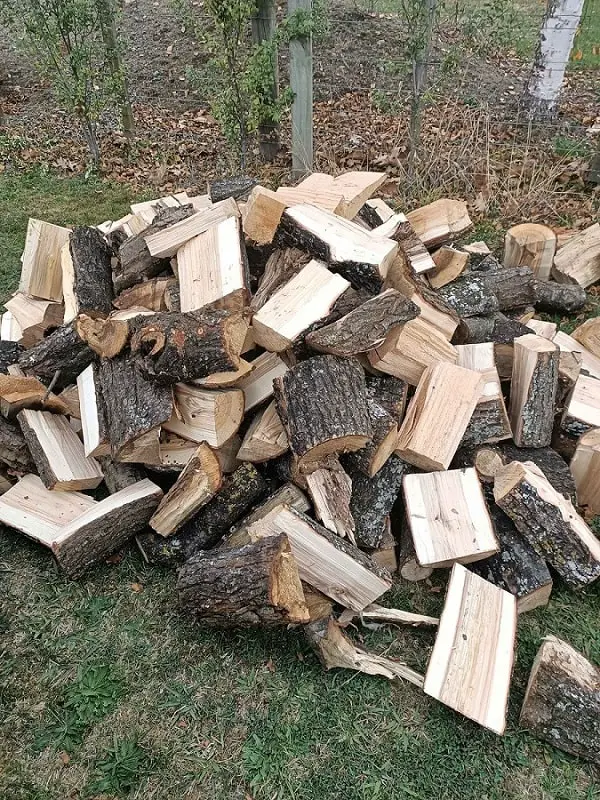
Splitting Axe or Maul
Splitting Mauls are made for splitting wood, and splitting wood only. You’re not going to chop down a tree with a maul. But because of its wide cheeks and edge which is duller than that of a felling axe (by design), you’ll be able to split even the largest rounds of wood. Regular axes – with flat, thin edges and cheeks – cut into the wood and get stuck there. A splitting maul, on the other hand, force the wood apart. If you’re interested, I’ve written a guide to the best splitting axes and mauls for the money, with a mix of affordable and premium options. You can read it by clicking that link!
In that guide my recommendation is the Fiskars X25 Splitting Axe. It lives up to Fiskars high reputation and has a comfortable composite handle with a thin edge that widens towards the handle and forces the wood fibers apart.
Mauls usually weight from 7 to 10 lbs (including handle weight, or roughly 6 to 8 lbs head weight.) They will also have a hard, flat face – like a hammer – on the back of the axehead for driving mauls into particularly tough wood such as oak, beech, or ash.
Splitting axes are not mauls. They are still proper axes, with cheeks that are thinner than those of mauls, but wider than those of normal axes. Their edges are less blunt and they are lighter than mauls. This makes splitting axes well-suited for several kinds of tasks – from splitting logs to rounds of wood and smaller half-rounds. They’re more versatile than mauls.
I have also put together a more comprehensive explanation of the difference between splitting axes and mauls that might help answer any further questions you have.
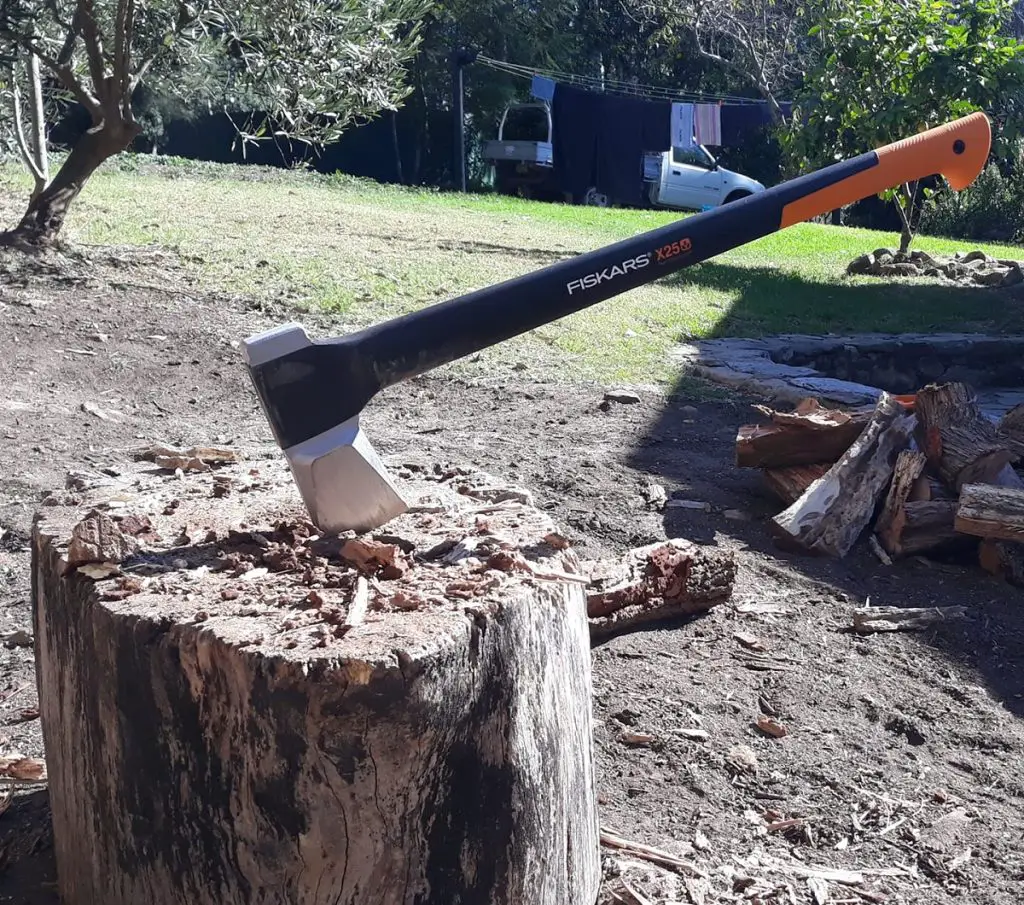
Splitting wedge
Wedges make a log-splitter’s life much easier. They do this by allowing you to keep one end of the log forced open while you split the center and other end. Even if you open up a split in the log with your maul or splitting axe, it’ll close back up when you remove the axehead for your next swing. This is a nightmare if you’re trying to split a large hardwood log, making the process several times longer. By driving a metal or composite plastic wedge into a cut you’ve made or a natural split within the log, you’ll be able to lengthen it and, with any luck, split the log with just a few more strokes. You can also use several wedges on a large and hard log to force it apart.
Wedges come in several different sizes and weights. Originally they were wedge-shaped (hence the name), but nowadays you can also get wedges in a diamond shape. If you are wondering how to split large logs, then use a splitting wedge to keep the fibers apart.
I use a bunch of Estwing Sure Split Wedges when splitting large hardwood logs.
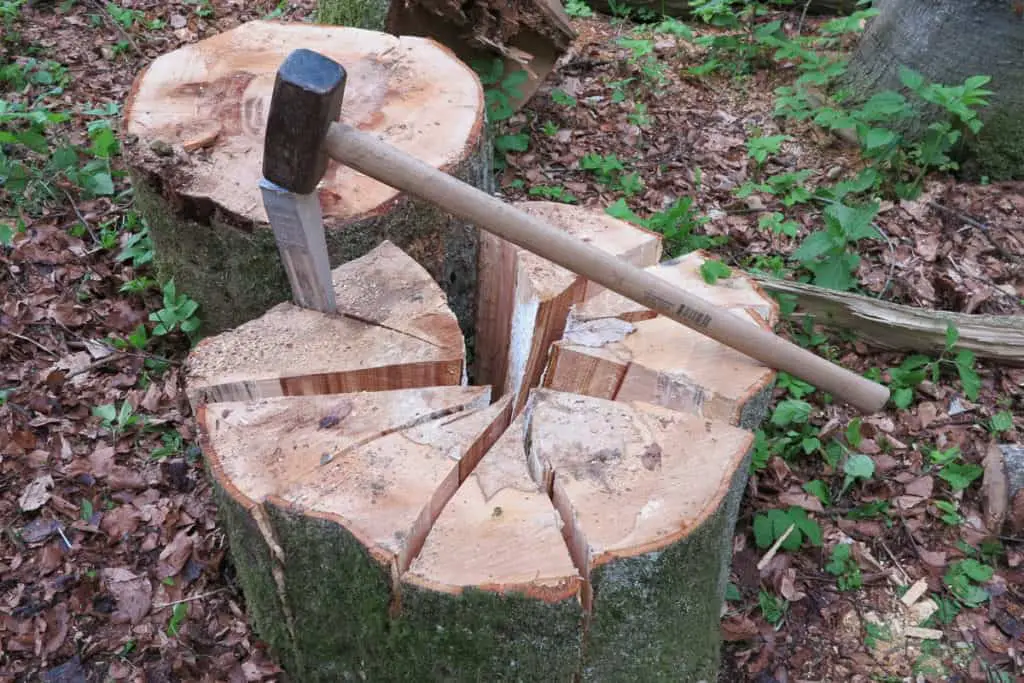
How to Split Wood with an Axe or Maul
- Stand with your feet placed evenly, shoulder-width apart. If you find it more comfortable, you can stand with one foot slightly in front of the other. Don’t exaggerate it because it’ll prevent you from using your hips to add power to the swing, which is the secret to effective, low-effort wood splitting.
- Raise your splitting axe or maul above your head and let it drop – no need to use strength trying to execute a big ol’ John Henry swing!
- As the axe drops, your dominant hand – which should start with gripping the handle just beneath the axehead – should slide down to meet your other hand at the base of the axe handle.
- As the axe drops, bend your knees and pull your hips back, so that your butt sticks out – this’ll add extra kinetic energy to the swing. You’re using your hips and legs in this technique, which is the secret to making wood splitting easy and doable for long sessions.
- If you’re splitting large rounds of wood, aim for a point midway between the edge of the round and the center. Trying to split it in the center will be more difficult because of the way wood fibers hold the whole thing together. The edges are weaker and easier to split. Once you’ve split a round once, it’ll be much easier to split it further into smaller pieces.
- If you’re splitting large and-or long logs, the same principle applies. Start at one end of the log, near where it has already been cut. Splitting it in the center will mean extra struggle and a waste of time. Work your way through from one end to the other.
SAFETY TIP: If you’re splitting a log, make sure it’s set firmly upon whatever surface you will be splitting on. Otherwise it can roll with a bad chop and even deflect the axe into your foot. That’s also why proper stance is important – keep your feet away from where you will be chopping wood! With rounds of wood, it’s possible and often a good idea to place them within an old tire. This will stop them from flying away when split and possibly catch the axe if you miss your swing.
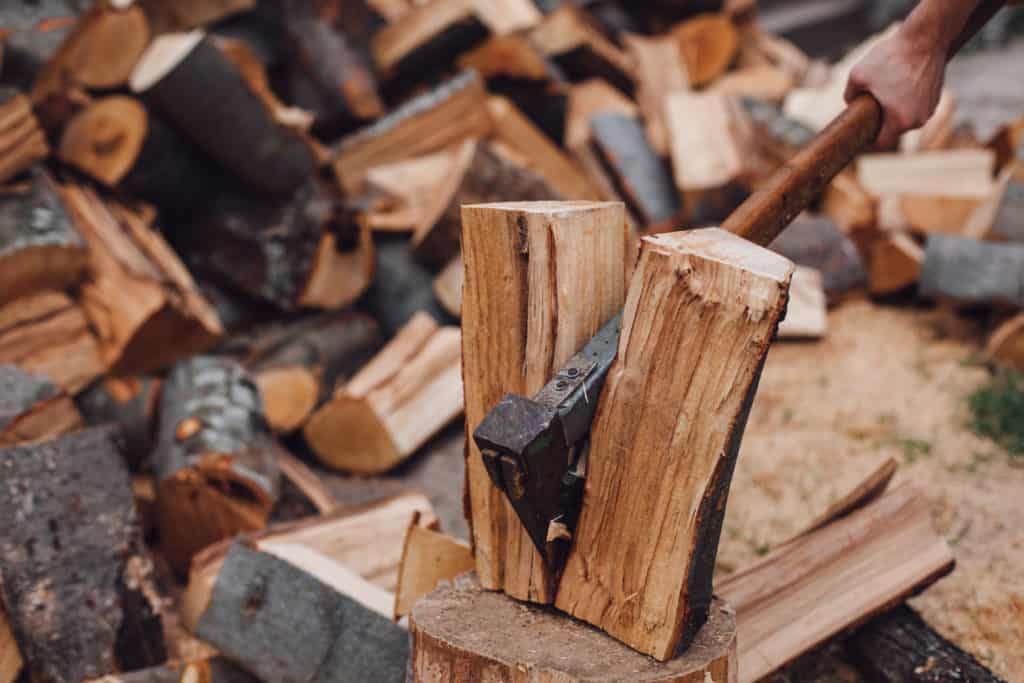
How to Split Wood with a Wedge
Wedges are great for splitting large logs or rounds of wood, or complementing a splitting axe or maul. That’s because wedges, once driven into the wood, hold the wood apart and keep up tension on the wood fibers, making it easier for you to finish splitting the wood with either more wedges or an axe or maul. Chopping firewood with a wedge is the best way to split large logs.
- Position the first wedge to go into or follow an existing split in the wood fiber. You can start on the face of the log cut, too.
- Use a hammer or maul to drive the wedge in. If you’re splitting green or very tough wood, you might need to make a few cut with an axe or a (hand or chain) saw to create the first split. Depending on the type of wood you have, you might need to sharpen your wedge (if it’s made from metal) to get best results.
- Once you’ve driven the wedge into the wood, leave it there and continue splitting with an axe, maul, or more wedges. I usually leave the butt of the wedge sticking out slightly so that I can pull or tap it out if necessary. Otherwise if it gets stuck and you can’t split the rest of the wood, it can be a pain to pull it out. This is especially true if you have only one wedge.
I’ve also written a guide to splitting wedges that you might find interesting. My recommendation is the Estwing Sure Split Wedge. It is a 5 pound wedge with extra wings on each side to improve the splitting potential.
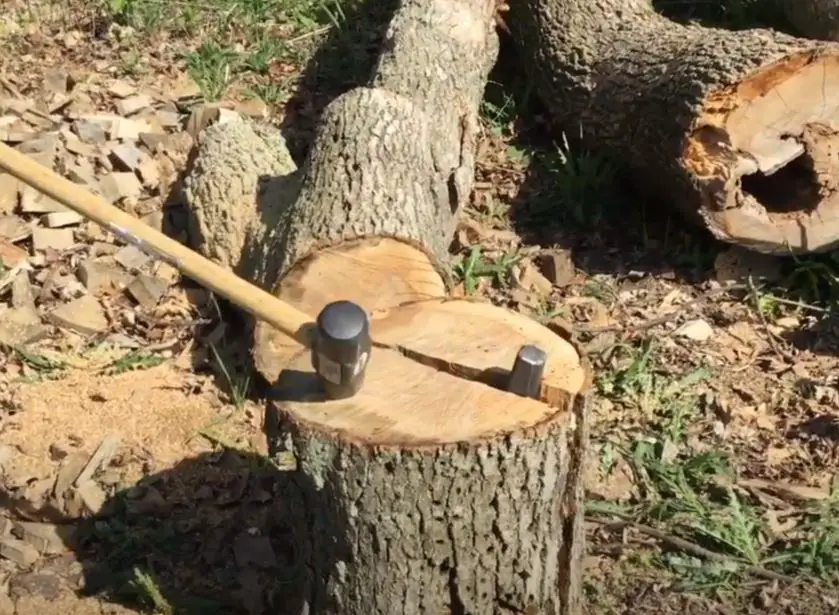
Safety Tips for Splitting Wood with an Axe
Use proper safety equipment, especially when operating chainsaws and mechanical wood splitters. This includes safety glasses or goggles, gloves, proper footwear (preferably steel-toed boots), and thick work clothes.
Use a chopping block for more comfortable splitting – a round of wood or a tree stump. You shouldn’t split firewood wood on a rocky or hard surface, such as metal – you’ll wreck your tools that way. A clean wooden chopping block will make sure your tools last longer.
Try to have another person nearby. They can help carry and sort the wood, but also help if you have an accident or get injured. With power tools especially, time is of the essence, and injuring yourself with a chainsaw, for example, can be fatal if you don’t receive first aid quickly. So don’t work alone!
Conclusion
Most of all – have fun! Splitting wood is something that many of us (me included) don’t have to do as an everyday chore. So enjoy it as a break from your daily routine, train those muscles you rarely use, and feel the satisfaction of turning a pile of logs or rounds of wood into proper firewood. It’s a beautiful sight!
